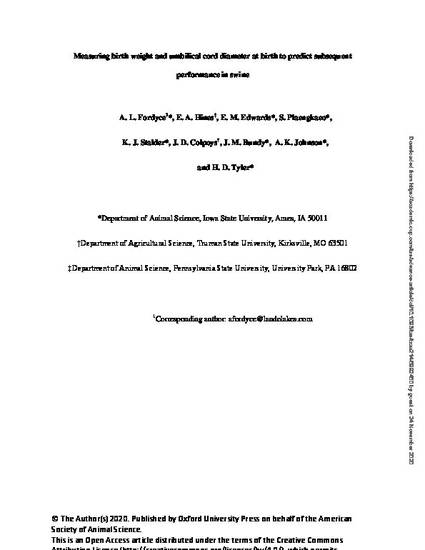
In the swine industry, pre-weaning mortality, umbilical hernia incidence and pig market weight are a few contributing factors affecting profitability and welfare on farm. Therefore, the ability to reliably predict any of these outcomes is valuable to swine operations. Mortality during the pre-weaning phase, umbilical hernia incidence and poor-quality finisher pigs can represent a multi-million dollar loss and increase in welfare concerns to the producer. Consequently, the objective of this study was to evaluate whether birth weight (BW), umbilical cord diameter at birth (UCD), and the calculated umbilical diameter at birth to birth weight ratio (UCD:BW), are potential indicators of both placental efficiency and relative defect size in the abdominal musculature as well as reliable predictors of pre-weaning mortality, umbilical hernia incidence, and pig body weight at 150 d of age in a commercial facility. Mixed sex commercial piglets were followed through production. Four hundred sixty-five piglets were weighed within 1 h of birth, and the UCD was determined using digital calipers, these animals were followed through weaning. Three hundred eighty-five pigs of the 465 were followed through the post-wean phase in the nursery facility and checked for umbilical hernia incidence. Finally, of the 385 pigs, 177 pigs were assessed for umbilical hernia incidence and weighed a final time at the grower-finisher facility. All data were analyzed using PROC Logistic and PROC GLM procedures. The variables of UCD:BW and BW were significantly associated with the probability of increased pre-weaning mortality (P < 0.001). For example, piglets with a low UCD:BW, but an increased BW had the greatest survival rate. Umbilical diameter (UCD) was not significantly associated with pre-weaning mortality. Post-weaning mortality was not significantly affected by UCD:BW, BW, or UCD variables. Umbilical hernia incidence was not significantly affected by UCD:BW at the nursery phase or growing-finishing phase. Pig body weight at 150 d of age was significantly affected by UCD:BW, BW, and UCD variables (P < 0.001). For example, piglets that had a larger UCD weighed more at 150 d of age. In conclusion, measuring the calculated UCD:BW has the potential to be a novel tool for future research looking into the impacts of umbilical measurements as it relates to placental function, fetal development, piglet survivability and impacts on future performance of the animal.
Available at: http://works.bepress.com/kenneth_stalder/247/

This article is published as Fordyce, A. L., E. A. Hines, E. M. Edwards, S. Plaengkaeo, K. J. Stalder, J. D. Colpoys, J. M. Bundy, A. K. Johnson, and H. D. Tyler. "Measuring birth weight and umbilical cord diameter at birth to predict subsequent performance in swine." Translational Animal Science 5 (2021): txaa214. doi: 10.1093/tas/txaa214.